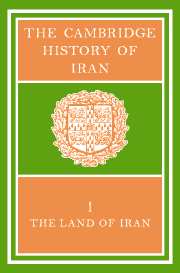Book contents
- Frontmatter
- PART 1 THE LAND
- PART 2 THE PEOPLE
- PART 3 ECONOMIC LIFE
- 15 MINERALS
- 16 INDUSTRIAL ACTIVITIES
- 17 COMMUNICATIONS, TRANSPORT, RETAIL TRADE AND SERVICES
- 18 AGRICULTURE
- 19 WATER USE IN NORTH-EAST IRAN
- 20 PASTORALISM, NOMADISM AND THE SOCIAL ANTHROPOLOGY OF IRAN
- 21 LAND REFORM IN IRAN
- PART 4 CONCLUSION
- Bibliography
- Conversion Tables
- Fig. I. Iran: physiographical.
- Plate Section
- Fig 85. Soil potentiality map of Iran.
- References
21 - LAND REFORM IN IRAN
from PART 3 - ECONOMIC LIFE
Published online by Cambridge University Press: 28 March 2008
- Frontmatter
- PART 1 THE LAND
- PART 2 THE PEOPLE
- PART 3 ECONOMIC LIFE
- 15 MINERALS
- 16 INDUSTRIAL ACTIVITIES
- 17 COMMUNICATIONS, TRANSPORT, RETAIL TRADE AND SERVICES
- 18 AGRICULTURE
- 19 WATER USE IN NORTH-EAST IRAN
- 20 PASTORALISM, NOMADISM AND THE SOCIAL ANTHROPOLOGY OF IRAN
- 21 LAND REFORM IN IRAN
- PART 4 CONCLUSION
- Bibliography
- Conversion Tables
- Fig. I. Iran: physiographical.
- Plate Section
- Fig 85. Soil potentiality map of Iran.
- References
Summary
Within the period of 1962–4, the Shāh and his Council of Ministers promulgated a series of decrees aimed at fundamental reform of the social, political, and economic structure of Iran. These reforms have become generally known as the “Six-point Reform” or the “Shāh's revolution”. The most significant measures in this reform programme are those concerned with agriculture and the system of land holding. Resulting transfer of large areas of agricultural land from the hands of a small group of proprietors to the mass of share-croppers will inevitably do much to alter the pattern of economic and social life within the country. In the following discussion, the legislative basis of the land reform, the background to its implementation, and the observable results arising from it will be examined in turn.
The speed with which land reform is currently being implemented has surprised opinion both within and outside the country. The need for some kind of reform had long been recognized, and as early as 1906 there was open advocacy of the re-distribution of landlord estates to the cultivating peasants during the Constitutional Movement of 1906-21. Yet, apart from tentative and largely unsuccessful attempts to distribute khāliseh (Domain Land) in Sīstān and Khūzistān, the land problem remained and the situation appeared highly intractable even to the most optimistic observer, who saw that “A wide-spread conservatism is … an obstacle to change: there has always been an endeavour on the part of the government and the landowners to maintain the status quo; a tendency in which, it must be admitted, the peasants largely Acquiesce”.
Keywords
- Type
- Chapter
- Information
- The Cambridge History of Iran , pp. 684 - 714Publisher: Cambridge University PressPrint publication year: 1968
References
- 28
- Cited by

